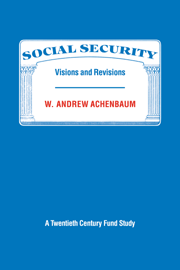Book contents
- Frontmatter
- Contents
- Dedication
- Foreword
- Acknowledgments
- Introduction
- Part I Social security comes of age
- Part II Current social security issues in historical perspective
- 5 Retirement under social security
- 6 Social security and the modern American woman
- 7 Universal coverage: an either/or proposition?
- 8 Federal health care programs and social security
- 9 A vision renewed: individual needs and mutual responsibility
- Notes
- Index
8 - Federal health care programs and social security
Published online by Cambridge University Press: 04 August 2010
- Frontmatter
- Contents
- Dedication
- Foreword
- Acknowledgments
- Introduction
- Part I Social security comes of age
- Part II Current social security issues in historical perspective
- 5 Retirement under social security
- 6 Social security and the modern American woman
- 7 Universal coverage: an either/or proposition?
- 8 Federal health care programs and social security
- 9 A vision renewed: individual needs and mutual responsibility
- Notes
- Index
Summary
The 1983 social security amendments addressed OASDI's financial problems, but they also dealt with Medicare. Government reports at the time indicated that the Hospital Insurance (HI) Trust Fund would be depleted by the late 1980s. Medicare's anticipated deficits over the next twenty-five years were almost as staggering as those estimated for the old-age retirement program during a seventy-five-year period.
The hearings on the NCSSR's “consensus package” presented a propitious moment to shore up the HI Trust Fund while attending to the OASDI program. Unlike most provisions in the 1983 legislation, however, proposals to stabilize health care financing were not based on NCSSR recommendations. (The problem of the HI Trust Fund was not within the scope of the commission's assignment.) The basis for change was found instead in the 1982 Tax Equity and Fiscal Responsibility Act (TEFRA), which altered payment methods for health care providers and increased beneficiaries' out-of-pocket expenses. To mobilize support for introducing health care issues into debate on the retirement program, lawmakers pledged that Medicare changes would be “budget neutral” through fiscal 1985 – that is, revisions would cost neither more nor less than changes already projected under current legislation. On this understanding, Congress swiftly enacted a new method for reimbursing hospitals.
Instead of paying for inpatient services on a virtually unchallenged “reasonable-cost” basis, as it had done for nearly twenty years, under the 1983 amendments Medicare would adhere over a three-year phase-in period to rates it established for 467 different diagnosis-related groups (DRGs).
- Type
- Chapter
- Information
- Social SecurityVisions and Revisions: A Twentieth Century Fund Study, pp. 161 - 178Publisher: Cambridge University PressPrint publication year: 1986



